How Lake Bogoria's rising waters hurt tourism, county revenue
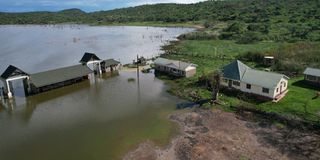
Some of the submerged structures at Lake Bogoria.
The rising water levels in Lake Bogoria have dealt a major blow to the local tourism sector and left the Baringo County Government struggling with reduced revenue.
Flooded hotels, submerged hot springs and impassable roads have driven tourists away, with local businesses bearing the brunt of the impact.
Over the past five years, the county's revenue collection has significantly declined due to the rising water levels that have led to the loss of properties worth millions of shillings.
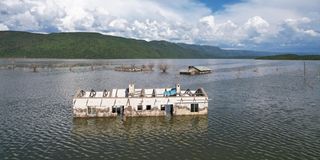
Some of the submerged structures at Lake Bogoria on April 15, 2025.
Lake Bogoria National Reserve was a major revenue earner for Baringo County before the Covid-19 pandemic, generating more than Sh100 million annually. However, revenue collection has declined from Sh100 million in 2019 to just Sh35 million in 2024, Nation.Africa has learned.
This decline has also affected the 10 percent annual equitable revenue share allocated to the local community, which fell from Sh8 million to just Sh200,000 last year.
Since 2020, the lake has expanded by more than 10 square kilometres--from 34 square kilometres to over 45 square kilometres--submerging buildings, including hotels, dispensaries, roads, the reserve's main gate and homesteads.
According to James Kimaru, a Lake Bogoria National Reserve Senior Warden and also a county government official, the drastic rise in water levels has forced flamingos to migrate to Lakes Nakuru and Elementaita in Nakuru County and Lake Lokipi in Turkana County.
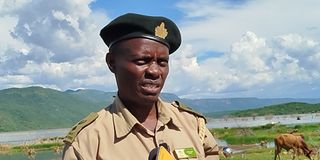
Lake Bogoria National Reserve senior warden James Kimaru on April 15, 2025.
He added that around 90 percent of the famous hot geysers, a major tourist attraction, had disappeared under the rising waters of the lake.
“Lake Bogoria is known globally as a tourist destination, particularly for its flamingos, hot springs, diverse wildlife, and more than 373 bird species. However, flooding has significantly affected this world-renowned site,” Mr Kimaru told Nation.Africa.
The lake used to have more flamingos than Lakes Magadi, Nakuru and Elementaita.
But the floods have reduced their numbers from more than 1.5 million to about 500,000.
The rivers that feed the lake, including the Waseges and Maji Moto, have changed their ecosystems, resulting in an increased inflow of fresh water.
This has changed the alkalinity of the lake, especially in the northern part where flamingos used to feed.
“Due to the increased inflow of fresh water, the lake’s chemistry—oxygen levels, pH, and temperature—has changed, affecting the algae that flamingos feed on. Most flamingos migrated to other lakes last year. The lake has since receded slightly, and flamingo numbers have begun to rise again this year,” Mr Kimaru said.
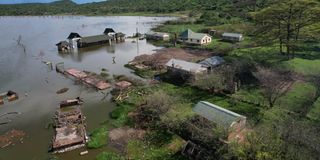
Some of the submerged structures at Lake Bogoria.
The flooding has also reduced open feeding areas for the flamingos, forcing them to land in shrub-covered areas.
“The tourism sector was hit hard as many campsites were submerged and major roads were destroyed. The county government had to spend more than Sh25 million to construct alternative routes,” said the warden.
The reserve's main gate and administration block, constructed in the 2017/2018 financial year at a cost of Sh30 million, are now submerged.
In addition, 26km of the Loboi-Emsos road within the reserve--built at a cost of Sh15 million--has also been submerged.
“Over the years, we have lost projects valued at more than Sh57.5 million,” Mr Kimaru said.
The pandemic, coupled with the flooding, led to a sharp drop in visitor numbers and revenue.
“Revenue from the reserve dropped from Sh100 million annually to a meagre Sh2 million in 2021. Last year, it slightly increased to Sh35 million, still far below previous levels,” he added.
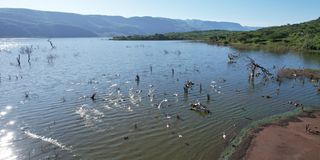
Flamingoes at Lake Bogoria on April 15, 2025. The number of flamingoes has reduced from 1.5 million in 2019 to about 500,000 due to rising water levels.
Ms Christine Kandie, an official with the Endorois Indigenous Women Empowerment Network, expressed concern that rising water levels had displaced families and destroyed livelihoods.
“We have experienced this phenomenon for the past 10 years. It has displaced people from their homes and climate change has affected wetlands, leading to a decline in flamingos, animals and birds,” she said.
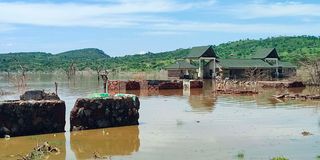
The main gate leading to the Lake Bogoria National Reserve that was submerged in water in this photo taken in September 2024.
Several structures near the lake, including the Loboi Dispensary, have been submerged. Many families have been displaced, creating challenges in shelter and food access.
The community's 10 percent revenue share fell from Sh8 million in 2019 to just Sh200,000 last year.
She added that many families, who previously relied on irrigation agriculture and livestock keeping, have had to reduce livestock numbers as grazing and farming areas have been submerged.
Lake Bogoria National Reserve, a Unesco World Heritage Site, is globally recognised for its geysers and hot springs. It is also designated as a Ramsar wetland of international importance.
The saline lake, one of several in the Great Rift Valley, hosts seasonal migrations of flamingos that fly in large V formations from Tanzania.


